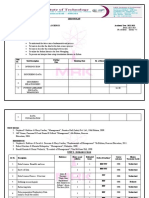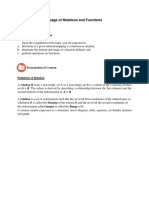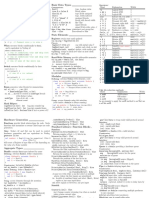0 ratings0% found this document useful (0 votes)
699 views03 - Decision - Tree - Hunt Algorithm
Hunt's algorithm is a decision tree induction algorithm developed in 1966. It builds a decision tree recursively by splitting the training records at each node into purer subsets based on an attribute test condition. If all records at a node belong to the same class, it becomes a leaf node labeled with that class. Otherwise, the records are partitioned into smaller subsets using an attribute test, creating a child node for each outcome. This process is repeated recursively on each child node until stopping criteria are met. The algorithm aims to construct a tree that accurately predicts class labels for new data instances.
Uploaded by
Avin Unggul Wijaya XI-MIPA-2Copyright
© © All Rights Reserved
We take content rights seriously. If you suspect this is your content, claim it here.
Available Formats
Download as PPT, PDF, TXT or read online on Scribd
0 ratings0% found this document useful (0 votes)
699 views03 - Decision - Tree - Hunt Algorithm
Hunt's algorithm is a decision tree induction algorithm developed in 1966. It builds a decision tree recursively by splitting the training records at each node into purer subsets based on an attribute test condition. If all records at a node belong to the same class, it becomes a leaf node labeled with that class. Otherwise, the records are partitioned into smaller subsets using an attribute test, creating a child node for each outcome. This process is repeated recursively on each child node until stopping criteria are met. The algorithm aims to construct a tree that accurately predicts class labels for new data instances.
Uploaded by
Avin Unggul Wijaya XI-MIPA-2Copyright
© © All Rights Reserved
We take content rights seriously. If you suspect this is your content, claim it here.
Available Formats
Download as PPT, PDF, TXT or read online on Scribd
You are on page 1/ 28
Hunt’s Algorithm
Algoritma Hunt
Sekolah Tinggi Ilmu Statistik Jakarta 1
Decision Tree Induction Algorithms
Number of Algorithms:
• Hunt’s
– Hunt's Algorithm (1966)
• Quinlan's
– Iterative Dichotomizer3 (1975) uses Entropy
– C4.5 / 4.8 / 5.0 (1993) uses Entropy
• Brieman's
– Classification And Regression Trees (1984) uses Gini
• Kass's
– CHi-squared Automatic Interaction Detector (1980) uses ____
• IBM:
Mehta
– Supervised Learning In Quest (1996) uses Gini
Shafer
– Scalable PaRallelizable INduction of decision Trees (1996) uses Gini
Sekolah Tinggi Ilmu Statistik Jakarta 2
Hunt’s Algorithm
• In the Hunt’s algorithm, a decision tree is
grown in a recursive fashion by partitioning
the training records successively into purer
subsets
Sekolah Tinggi Ilmu Statistik Jakarta 3
Hunt’s Algorithm
• Let Dt be the set of training records that are
associated with node t and y = {y1, y2, · · · , yc}
be the class labels. The following is a recursive
definition of Hunt’s algorithm.
• Step 1: If all the records in Dt belong to the
same class yt, then t is a leaf node labeled as
yt.
Sekolah Tinggi Ilmu Statistik Jakarta 4
Hunt’s Algorithm
• Step 2: If Dt contains records that belong to
more than one class, an attribute test
condition is used to partition the records into
smaller subsets. A child node is then created
for each outcome of the test condition. The
records in Dt are distributed to the children
based upon their outcomes. This procedure is
repeated for each child node.
Sekolah Tinggi Ilmu Statistik Jakarta 5
Hunt’s Algorithm
Dt = {training records @ node t}
• If Dt = {records from different classes}
– Split Dt into smaller subsets via attribute test
– Traverse each subset with same rules
• If Dt = {records from single class yt}
– Set Node t = leaf node with class label yt
• If Dt = {} (empty)
– Set Node t = leaf node with default class label
yd
• Recursively apply above criterion until ...
– No more training records left
Sekolah Tinggi Ilmu Statistik Jakarta 6
Example
• Consider the problem of predicting whether a
loan applicant will succeed in repaying her
loan obligations or become delinquent, and
subsequently, default on her loan.
• The training set used for predicting borrowers
who will default on their loan payments will
be as follows.
Sekolah Tinggi Ilmu Statistik Jakarta 7
Example. Figure1
Sekolah Tinggi Ilmu Statistik Jakarta 8
Example
• A training set for this problem can be
constructed by examining the historical
records of previous loan borrowers.
• In the training set shown in Figure 1, each
record contains the personal information of a
borrower along with a class label indicating
whether the borrower has defaulted on her
loan payments.
Sekolah Tinggi Ilmu Statistik Jakarta 9
Example
• The initial tree for the classification problem
contains a single node with class label
Defaulted = No as illustrated below:
Figure 1a: Step 1
• This means that most of the borrowers had
successfully repayed their loans.
• However, the tree needs to be refined since
the root node contains records from both
classes. Sekolah Tinggi Ilmu Statistik Jakarta 10
Example
• The records are subsequently divided into smaller
subsets based on the outcomes of the Home
Owner test condition, as shown in Figure below:
Figure 1b: Step 2
• The reason for choosing this attribute test
condition instead of others is an implementation
issue that will be discussed later.
Sekolah Tinggi Ilmu Statistik Jakarta 11
Example
• Now we can assume that this is the best
criterion for splitting the data at this point.
• The Hunt’s algorithm is then applied
recursively to each child of the root node.
• From the training set given in Figure 1, notice
that all borrowers who are home owners had
successfully repayed their loan.
Sekolah Tinggi Ilmu Statistik Jakarta 12
Example
• As a result, the left child of the root is a leaf
node labeled as Defaulted = No as shown in
figure 1b
• For the right child of the root node, we need
to continue applying the recursive step of
Hunt’s algorithm until all the records belong
to the same class.
Sekolah Tinggi Ilmu Statistik Jakarta 13
Example
• This recursive step is shown in Figures 1c and
d below:
Figure1c: Step 3 Figure 1d: step 4
Sekolah Tinggi Ilmu Statistik Jakarta 14
Example
• Generally the whole diagram will be as follows
Sekolah Tinggi Ilmu Statistik Jakarta 15
Design Issues of Decision Tree
Induction
• How to split the training records? - Each
recursive step of the tree growing process
requires an attribute test condition to divide
the records into smaller subsets.
• To implement this step, the algorithm must
provide a method for specifying the test
condition for different attribute types as well as
an objective measure for evaluating the
goodness of each test condition.
Sekolah Tinggi Ilmu Statistik Jakarta 16
Design Issues of Decision Tree
Induction
• When to stop splitting? A stopping condition is
needed to terminate the tree growing
process.
• A possible strategy is to continue expanding a
node until all the records belong to the same
class or if all the records have identical
attribute values.
Sekolah Tinggi Ilmu Statistik Jakarta 17
How to Split an Attribute
• Before automatically creating a decision tree,
you can choose from several splitting
functions that are used to determine which
attribute to split on. The following splitting
functions are available:
– Random - The attribute to split on is chosen
randomly.
– Information Gain - The attribute to split on is the
one that has the maximum information gain.
Sekolah Tinggi Ilmu Statistik Jakarta 18
How to Split an Attribute
– Gain Ratio - Selects the attribute with the highest
information gain to number of input values ratio.
The number of input values is the number of
distinct values of an attribute occurring in the
training set.
– GINI - The attribute with the highest GINI index is
chosen. The GINI index is a measure of impurity of
the examples.
Sekolah Tinggi Ilmu Statistik Jakarta 19
Training Dataset
Age Income Student CreditRating BuysComputer
<=30 high no fair no
<=30 high no excellent no
31 - 40 high no fair yes
>40 medium no fair yes
>40 low yes fair yes
>40 low yes excellent no
31 - 40 low yes excellent yes
<=30 medium no fair no
<=30 low yes fair yes
>40 medium yes fair yes
<=30 medium yes excellent yes
31 - 40 medium no excellent yes
31 - 40 high yes fair yes
Sekolah Tinggi Ilmu Statistik Jakarta 20
>40 medium no excellent no
Resultant Decision Tree
Sekolah Tinggi Ilmu Statistik Jakarta 21
Attribute Selection Measure:
Information Gain (ID3/C4.5)
• The attribute selection mechanism used in ID3
and based on work on information theory by
Claude Shannon
• If our data is split into classes according to
fractions {p1,p2…, pm} then the entropy is
measured as the info required to classify any
arbitrary tuple as follows:
m
E ( p1 ,p2 ,...,pm ) pi log 2 pi
i 1
Sekolah Tinggi Ilmu Statistik Jakarta 22
Attribute Selection Measure:
Information Gain (ID3/C4.5) (cont…)
• The information measure is essentially the
same as entropy
• At the root node the information is as follows:
9 5
info [9,5] E ,
14 14
9 9 5 5
log 2 log 2
14 14 14 14
0.94
Sekolah Tinggi Ilmu Statistik Jakarta 23
Attribute Selection Measure:
Information Gain (ID3/C4.5) (cont…)
• To measure the information at a particular
attribute we measure info for the various
splits of that attribute
• For instance with age attribute look at the
distribution of ‘Yes’ and ‘No’ samples for each
value of age. Compute the expected
information for each of these distribution.
• For age “<=30”
Sekolah Tinggi Ilmu Statistik Jakarta 24
Attribute Selection Measure:
Information Gain (ID3/C4.5) (cont…)
• At the age attribute the information is as
follows:
5 4 5
info [2,3], [4,0], [3,2] info 2,3 info 4,0 info 3,2
14 14 14
5 2 2 3 3
log 2 log 2
14 5 5 5 5
4 4 4 0 0
log 2 log 2
14 4 4 4 4
5 3 3 2 2
log 2 log 2
14 5 5 5 5
0Sekolah
.694Tinggi Ilmu Statistik Jakarta 25
Attribute Selection Measure:
Information Gain (ID3/C4.5) (cont…)
• In order to determine which attributes we
should use at each node we measure the
information gained in moving from one node
to another and choose the one that gives us
the most information
Sekolah Tinggi Ilmu Statistik Jakarta 26
Attribute Selection By Information
Gain Example
• Class P: BuysComputer = “yes”
• Class N: BuysComputer = “no”
– I(p, n) = I(9, 5) =0.940
• Compute the entropy for age:
Age Income Student CreditRating BuysComputer
<=30 high no fair no Age pi ni I(pi, ni)
<=30 high no excellent no
31 - 40 high no fair yes >=30 2 3 0.971
>40 medium no fair yes
>40 low yes fair yes 30 – 40 4 0 0
>40 low yes excellent no
31 - 40 low yes excellent yes
<=30 medium no fair no
>40 3 2 0.971
<=30 low yes fair yes
>40 medium yes fair yes
<=30 medium yes excellent yes
31 - 40 medium no excellent yes
31 - 40 high yes Sekolah
fair Tinggi Ilmu Statistik Jakarta
yes 27
Attribute Selection By Information
Gain Computation
5 4 5
E (age) I (2,3) I (4,0) I (3,2)
14 14 14
0.694
• means “age <=30” has 5 out of 14 samples,
with 2 yes and 3 no. Hence:
Similarly:
Gain(income) 0.029
Gain( student ) 0.151
Gain(credit _ rating ) 0.048
Sekolah Tinggi Ilmu Statistik Jakarta 28
You might also like
- Practical File: Internet Programming LabNo ratings yetPractical File: Internet Programming Lab26 pages
- Module-3 Association Analysis: Data Mining Association Analysis: Basic Concepts and AlgorithmsNo ratings yetModule-3 Association Analysis: Data Mining Association Analysis: Basic Concepts and Algorithms34 pages
- FIND-S Algorithm: Machine Learning 15CSL76No ratings yetFIND-S Algorithm: Machine Learning 15CSL763 pages
- Machine Learning: PAC-Learning and VC-DimensionNo ratings yetMachine Learning: PAC-Learning and VC-Dimension31 pages
- Unit - IV - DIMENSIONALITY REDUCTION AND GRAPHICAL MODELSNo ratings yetUnit - IV - DIMENSIONALITY REDUCTION AND GRAPHICAL MODELS59 pages
- Objective: For One Dimensional Data Set (7,10,20,28,35), Perform Hierarchical ClusteringNo ratings yetObjective: For One Dimensional Data Set (7,10,20,28,35), Perform Hierarchical Clustering13 pages
- Question Bank Module-1: Department of Computer Applications 18mca53 - Machine LearningNo ratings yetQuestion Bank Module-1: Department of Computer Applications 18mca53 - Machine Learning7 pages
- Lecture - 2 Classification (Machine Learning Basic and KNN)No ratings yetLecture - 2 Classification (Machine Learning Basic and KNN)94 pages
- Practical 5: Introduction To Weka For Classfication100% (1)Practical 5: Introduction To Weka For Classfication4 pages
- 1) Aim: Demonstration of Preprocessing of Dataset Student - ArffNo ratings yet1) Aim: Demonstration of Preprocessing of Dataset Student - Arff26 pages
- Unit 5 - Data Mining - WWW - Rgpvnotes.inNo ratings yetUnit 5 - Data Mining - WWW - Rgpvnotes.in15 pages
- Subsets, Graph Coloring, Hamiltonian Cycles, Knapsack Problem. Traveling Salesperson ProblemNo ratings yetSubsets, Graph Coloring, Hamiltonian Cycles, Knapsack Problem. Traveling Salesperson Problem22 pages
- Anna University, Chennai Non-Autonomous Affiliated Colleges Regulations 2021 Choice Based Credit System B.E. Computer Science and EngineeringNo ratings yetAnna University, Chennai Non-Autonomous Affiliated Colleges Regulations 2021 Choice Based Credit System B.E. Computer Science and Engineering86 pages
- JNTUK R20 B.Tech CSE 3-2 Machine Learning Unit 4 NotesNo ratings yetJNTUK R20 B.Tech CSE 3-2 Machine Learning Unit 4 Notes23 pages
- Software Engineering Tools and PracticesNo ratings yetSoftware Engineering Tools and Practices37 pages
- Computer Number Systems and Boolean Algebra Notes Formula SheetNo ratings yetComputer Number Systems and Boolean Algebra Notes Formula Sheet2 pages
- Digital Logic Design Boolean Algebra and Logic SimplificationNo ratings yetDigital Logic Design Boolean Algebra and Logic Simplification46 pages
- 1.relations and Functions - Self EvaluationNo ratings yet1.relations and Functions - Self Evaluation1 page
- Module 1: Fibonacci Numbers and The Golden Ratio: MMW ReviewerNo ratings yetModule 1: Fibonacci Numbers and The Golden Ratio: MMW Reviewer11 pages
- Towards A Definition of An Algorithm: Journal of Logic and Computation February 2006No ratings yetTowards A Definition of An Algorithm: Journal of Logic and Computation February 200639 pages

























































































